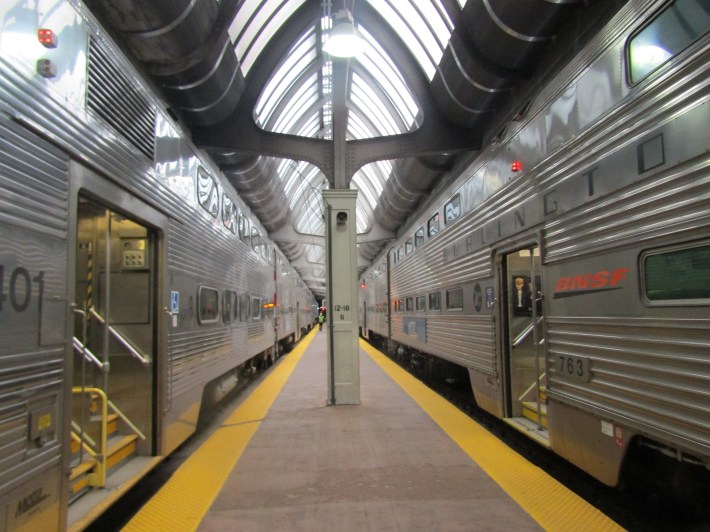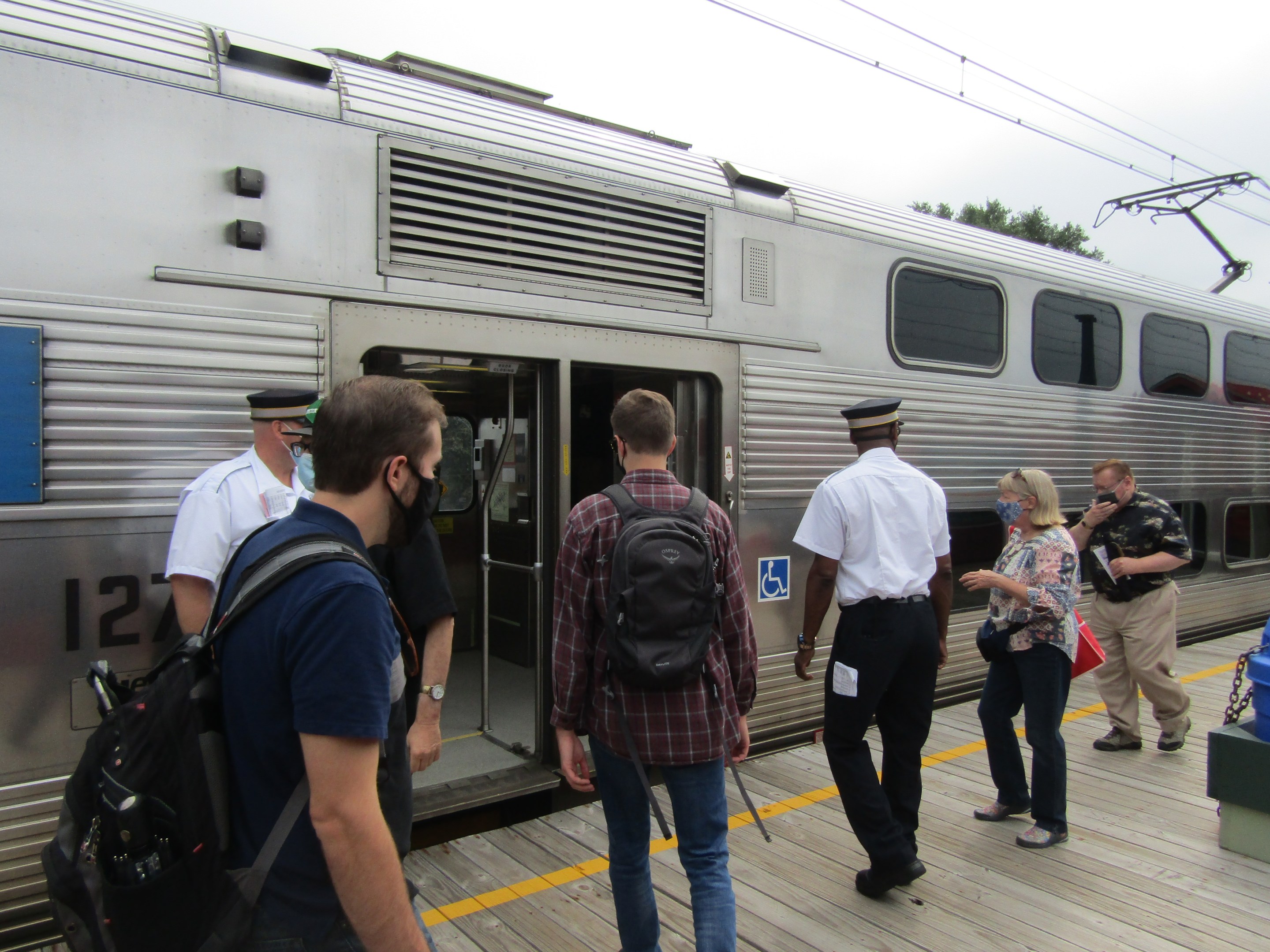The jury is still out on whether the Fair Transit South Cook reduced fare pilot, which launched in January 2021, has increased ridership on the Metra Electric District and Rock Island District lines. Obviously with local transit ridership still recovering from the COVID-19 quarantine, this has not been a typical year for passenger counts. But one thing that is clear: Ever since the pandemic started, even before the pilot launched, those two South Side two lines have accounted for the higher share of overall system ridership than before.
Under the three-year pilot, the regular fares for the MED and RID are the same as the usual reduced fares, so that trips within Chicago city limits cost only slightly more than CTA ‘L’ rides. Pace increased service on Route 325, which serves Halsted Street between 95th/Dan Ryan Red Line station and the Chicago Heights Transportation Center, adding transfer options between the route and the Metra Electric’s main and Blue Island branches. While the pilot was conceived well before the pandemic was a thing, the crisis didn't stop Cook County, which is spearheading the initiative, from moving forward with the pilot.
The program launched during a time when the three commuter lines operated by the Union Pacific Railroad under contract with Metra – the Union Pacific North, Union Pacific Northwest, and Union Pacific West routes – were essentially free to ride because UP refused to have its conductors collect fares, claiming it was a pandemic safety issue. Fare collection resumed on those lines in June.
During last month's “Emerging From the Pandemic Wiser” panel, hosted by University of Illinois at Chicago’s Urban Transportation Center, panelists disagreed on whether Fair Transit South Cook has had much influence on residents' commuting habits.
David Bragdon, executive director at the TransitCenter foundation (a Streetsblog Chicago funder), argued that service frequency was more important than fare reductions. However, Heidy Persaud, director of transportation equity at the Center for Neighborhood Technology, argued that Bragdon was underestimating how much of a difference the lower fares are making. That disagreement inspired Streetblog to look into the ridership numbers in an effort to see which side was right.
Reflecting fluctuating COVID restrictions and Metra service schedules, system ridership has gone up and down several times during the past two years, making any kind of apples-to-apples comparison difficult. Therefore we decided to focus on ridership share, since it is the best indicator of how each line is performing relative to the rest of the system.
We found that, while MED and RID saw ridership spikes when the pilot launched, that didn’t translate into a consistent increase. Even before Fair Transit South Cook launched in early 2021, the pilot lines were already doing better than they were pre-pandemic, to the point where they had knocked the Union Pacific West Line down from fourth-highest ridership spot to the sixth.
Judging from Metra monthly ridership reports, the de-facto free fares on the three Union Pacific lines while conductors weren't checking tickets didn’t have any discernible effect on ridership numbers. However, ridership counts on these lines between the start of lockdown in March 2020 through June 2021, when fare collection resumed, were largely based on conductor estimates rather than ticket sales, so the passengers may have be undercounted.

Ridership trends
Before the pandemic, Metra ridership tended to follow a fairly steady pattern. The BNSF line was usually the busiest route, followed by the UP-Northwest, UP-North, and UP-West lines. MED and RID ridership was closer to the middle, regularly trading fifth and sixth places.
In April and May 2020, when the most stringent stay-at-home restrictions were in effect and Metra schedules were stripped down to the bone, the MED climbed to the top spot, while the UP-N reached second place, the BNSF dropped to third, and the UP-Northwest and RID alternated between fourth and fifth places.
In June 2020, when some of the stay-at-home restrictions were relaxed, Metra started rebuilding its schedules and conductors started collecting tickets (except on the Union Pacific lines), ridership increased across the entire system. The BNSF line returned to first place, the RID jumped to second place, the UP-Northwest came in third, the MED was fourth, and UP-North came in fifth.
From July to September 2020, a new pattern emerged, with the BNSF remaining in first place, the UP-North and UP-Northwest trading second and third spots, the MED and RID coming in forth and fifth, and the UP-West staying in the sixth place.
In October 2020, as ridership dropped across the system amidst rising COVID cases and Union Pacific started collecting fares at the Ogilvie Transportation Center (but still not on trains), the UP-North and UP-Northwest pulled up to the top two spots, while the MED, RID and UP-West remained in the same spots as before. That remained true in November, but things returned to the summer pattern in December.
In January 2021, the first month Fair Transit South Cook, the MED shot to second place, the UP-North and UP-Northwest came in third and forth, and the RID remained in fifth place. Both pilot lines saw ridership increases, with the MED going from 68,423 to 73,492 daily riders and the RID increasing from 59,209 to 67,463 daily riders. But three non-pilot lines that saw no schedule or fare changes experienced ridership increases as well that month. The BNSF Line went from 75,764 to 78,016 riders, The SouthWest Service line went from 12,420 to 12,906, and the North Central Service went from 3,684 to 4,050 riders.
In February 2021, the MED dropped to third place, with ridership dropping to 71,261 riders. The RID remained in fifth place, with its ridership numbers decreasing to 65,398 riders. Meanwhile, the UP-Northwest came in second, the UP-North dropped to fourth place, and the UP-West remained in sixth place.
In the spring of 2021, as vaccines became more widely available, ridership increased on all lines. The MED dropped to fourth place in April and stayed there, while the UP-North climbed from fourth place to second place over the course of three months, and the UP-Northwest dropped to third place in May.
Metra restored Saturday schedules for most lines (except the SouthWest Service) on Memorial Day weekend and Union Pacific resumed onboard fare collection at the start of June. Ridership increased system-wide, but in terms of ridership shares, the only difference was that the two Fair Transit South Cook lines swapped places. The pattern remained the same for the rest of the summer, save for the top two Union Pacific lines trading places.
September 2021 saw six lines lose ridership, but fives lines – including the two pilot lines – saw increases. The MED jumped to third place, with ridership increasing from 187,972 to 217,274, while the RID remained in fifth place but saw a slight increase from 185,030 to 185,409. Interestingly, the other three were the lines that consistently remained in the bottom three before and during the pandemic. The SouthWest Service went from 33,322 to 35,908 riders, the North Central Service went from 18,315 to 18,325 (gaining only 20 riders, but a gain is a gain), and the Heritage Corridor went from 9,466 to 10,088.
October 2021, the last month for which the ridership figures are currently available, saw ridership increase on all lines. The MED jumped to second place and the UP-North dropped down to third, but otherwise, the ridership shares remained the same. MED ridership increased to 236,831 while RID ridership increased to 194,203.
Metra spokesperson Michael Gillis declined to comment on the pilot, deferring to Cook County officials.
County spokesperson Natalia Derevyanny said county leaders were well aware that the pandemic changed the situation, but they decided to go ahead with the pilot anyway because “We recognized that our communities in the Southland [a term for the South Side and south suburbs] were home to a majority of our essential workers and those same communities were bearing the brunt of the pandemic’s negative impacts.”
“We wanted to ensure that the residents who travel to and from these communities had affordable and reliable transit options during an extremely challenging time,” Derevyanny added. “Our focus has always been and continues to be a transit system that is sustainable for our transit partners and both affordable and accessible for our residents. We continue to monitor the impacts the pandemic has on transit and for the time being are focused on ensuring that our residents are able to access their jobs and vital services during the pandemic.”
While Derevyanny didn’t elaborate on how the county would judge the success or failure of the pilot under pandemic conditions, she said that the county, Metra, and Pace will look at “ridership, fare structure, and transit schedules” and see if anything will need to be change. Their findings will be made available to the public.



